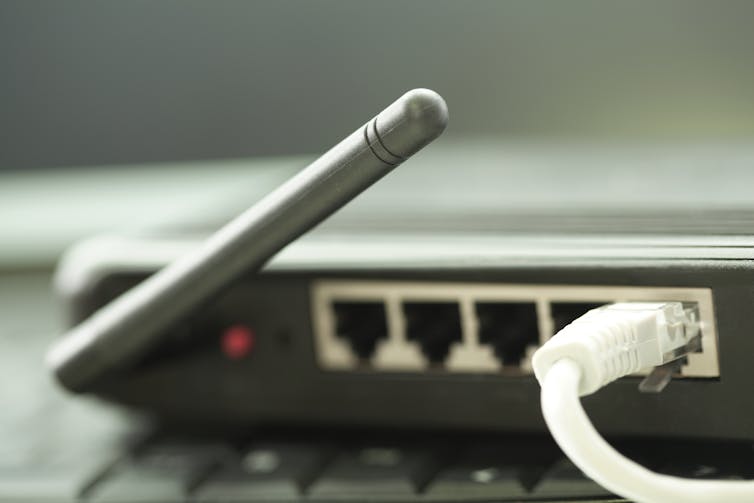How does Wi-Fi work? An electrical engineer explains
- Written by Bhaskar Krishnamachari, Professor of Electrical Engineering, University of Southern California
Though you can’t see them, radio waves are all around you all the time, carrying information. For most people, some of those radio waves are Wi-Fi signals. Wi-Fi is the catchy name an industry alliance came up[1] with to market devices that transmit large amounts of data over short distances using radio waves. The letters don’t stand for anything.
Wi-Fi, like broadcast radio and cellular telephone signals, is based on scientific discoveries dating back to the late 19th century. When electrons moving through a wire are made to alternate directions periodically, something magical happens. Electrons in another wire, located at a distance, start to move up and down in sync, as though they were telepathically connected.
This phenomenon was first observed by Heinrich Hertz[2] in 1887, confirming a mathematical theory proposed by James Clerk Maxwell[3] in 1864. Maxwell’s elegant theory explains how the alternating current in the first wire causes a “radio wave” of alternating electrical and magnetic fields to radiate out in all directions at the speed of light. The wave, in turn, causes an alternating current in the second wire.
The electromagnetic spectrum[4] includes visible light, which alternates at a much higher frequency than radio waves. There is a mystery to ponder here: Human bodies have evolved to see light but not radio waves.
 This little antenna transmits radio waves throughout an apartment-size area.
deepblue4you/E+ via Getty Images[5]
This little antenna transmits radio waves throughout an apartment-size area.
deepblue4you/E+ via Getty Images[5]
Wireless 0’s and 1’s
Traditional AM/FM radio and TV broadcasts communicate information through analog, or continuous, signals. Wi-Fi communicates information digitally, as discrete values – the 0’s and 1’s of binary data. This lets mobile devices easily send a wide range of data types, including video, image, speech and text. Digitally formatted data is also easier to compress for faster download, to encode for preventing errors and to encrypt for ensuring confidentiality.
When you search for something online, data from your Wi-Fi device is first communicated over radio waves to a Wi-Fi access point, which could be the antenna on the back of your home internet router or a Wi-Fi antenna in a café. It then travels over wired cables to a gateway device operated by your broadband internet provider. From there, the query finds its way across multiple wired links to Google’s server. The response comes back through a similar path in reverse.
Wi-Fi devices made by different companies can talk to each other. This is because they follow a common set of rules called the 802.11 standards[6], published by the Institute for Electrical and Electronic Engineers, the IEEE. These rules specify how 0’s and 1’s are represented using radio waves and how devices identify themselves. They also specify an algorithm for how and when to talk, called carrier-sense multiple access[7], or CSMA.
 The key to making Wi-Fi practical is in how it juggles multiple people using it at once.
The Creative Exchange/Unsplash[8]
The key to making Wi-Fi practical is in how it juggles multiple people using it at once.
The Creative Exchange/Unsplash[8]
CSMA makes Wi-Fi devices both polite and smart. They always listen before they talk, to check that no other nearby devices are transmitting. To further minimize talking at the same time, they roll dice to pick random times to transmit. And when there are more devices around, they speak less often. All of this happens too quickly to notice.
[Expertise in your inbox. Sign up for The Conversation’s newsletter and get expert takes on today’s news, every day.[9]]
Fast, but not always strong
You may sometimes have trouble connecting to a Wi-Fi access point. Here is why: Radio signals get weaker with distance. Thick walls, metal shelves and even an aquarium can weaken and obstruct radio waves. If the signal gets too weak, there is poor or no communication. If there are too many Wi-Fi networks nearby, they may also interfere with your link.
Several improved versions of Wi-Fi have emerged since it first appeared in the mid-1990s. Its maximum data rate[10] – several billion bits per second – is now more than a thousand times higher than the earliest version. This is why we can have video conference calls over Wi-Fi today.
Emerging applications like virtual reality gaming demand ever-higher download speeds. They are likely to drive even further improvements in Wi-Fi.
References
- ^ industry alliance came up (boingboing.net)
- ^ Heinrich Hertz (www.aaas.org)
- ^ James Clerk Maxwell (physicsworld.com)
- ^ electromagnetic spectrum (science.nasa.gov)
- ^ deepblue4you/E+ via Getty Images (www.gettyimages.com)
- ^ 802.11 standards (www.networkworld.com)
- ^ carrier-sense multiple access (www.geeksforgeeks.org)
- ^ The Creative Exchange/Unsplash (unsplash.com)
- ^ Expertise in your inbox. Sign up for The Conversation’s newsletter and get expert takes on today’s news, every day. (theconversation.com)
- ^ maximum data rate (www.lifewire.com)
Authors: Bhaskar Krishnamachari, Professor of Electrical Engineering, University of Southern California
Read more https://theconversation.com/how-does-wi-fi-work-an-electrical-engineer-explains-148156


